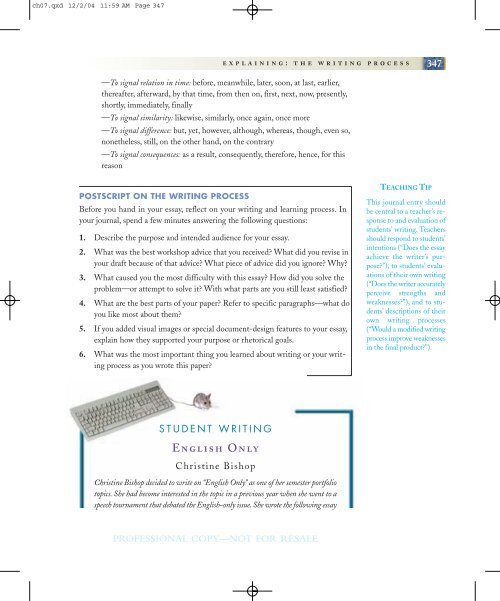A prolific painter of portraits before and after the French Revolution ...
A prolific painter of portraits before and after the French Revolution ...
A prolific painter of portraits before and after the French Revolution ...
Create successful ePaper yourself
Turn your PDF publications into a flip-book with our unique Google optimized e-Paper software.
ch07.qxd 12/2/04 11:59 AM Page 347<br />
explaining:<br />
<strong>the</strong> writing process<br />
347<br />
—To signal relation in time: <strong>before</strong>, meanwhile, later, soon, at last, earlier,<br />
<strong>the</strong>re<strong>after</strong>, <strong>after</strong>ward, by that time, from <strong>the</strong>n on, first, next, now, presently,<br />
shortly, immediately, finally<br />
—To signal similarity: likewise, similarly, once again, once more<br />
—To signal difference: but, yet, however, although, whereas, though, even so,<br />
none<strong>the</strong>less, still, on <strong>the</strong> o<strong>the</strong>r h<strong>and</strong>, on <strong>the</strong> contrary<br />
—To signal consequences: as a result, consequently, <strong>the</strong>refore, hence, for this<br />
reason<br />
POSTSCRIPT ON THE WRITING PROCESS<br />
Before you h<strong>and</strong> in your essay, reflect on your writing <strong>and</strong> learning process. In<br />
your journal, spend a few minutes answering <strong>the</strong> following questions:<br />
1. Describe <strong>the</strong> purpose <strong>and</strong> intended audience for your essay.<br />
2. What was <strong>the</strong> best workshop advice that you received? What did you revise in<br />
your draft because <strong>of</strong> that advice? What piece <strong>of</strong> advice did you ignore? Why?<br />
3. What caused you <strong>the</strong> most difficulty with this essay? How did you solve <strong>the</strong><br />
problem—or attempt to solve it? With what parts are you still least satisfied?<br />
4. What are <strong>the</strong> best parts <strong>of</strong> your paper? Refer to specific paragraphs—what do<br />
you like most about <strong>the</strong>m?<br />
5. If you added visual images or special document-design features to your essay,<br />
explain how <strong>the</strong>y supported your purpose or rhetorical goals.<br />
6. What was <strong>the</strong> most important thing you learned about writing or your writing<br />
process as you wrote this paper?<br />
TEACHING TIP<br />
This journal entry should<br />
be central to a teacher’s response<br />
to <strong>and</strong> evaluation <strong>of</strong><br />
students’ writing. Teachers<br />
should respond to students’<br />
intentions (“Does <strong>the</strong> essay<br />
achieve <strong>the</strong> writer’s purpose?”),<br />
to students’ evaluations<br />
<strong>of</strong> <strong>the</strong>ir own writing<br />
(“Does <strong>the</strong> writer accurately<br />
perceive strengths <strong>and</strong><br />
weaknesses?”), <strong>and</strong> to students’<br />
descriptions <strong>of</strong> <strong>the</strong>ir<br />
own writing processes<br />
(“Would a modified writing<br />
process improve weaknesses<br />
in <strong>the</strong> final product?”).<br />
STUDENT WRITING<br />
English Only<br />
Christine Bishop<br />
Christine Bishop decided to write on “English Only” as one <strong>of</strong> her semester portfolio<br />
topics. She had become interested in <strong>the</strong> topic in a previous year when she went to a<br />
speech tournament that debated <strong>the</strong> English-only issue. She wrote <strong>the</strong> following essay<br />
PROFESSIONAL COPY—NOT FOR RESALE

















